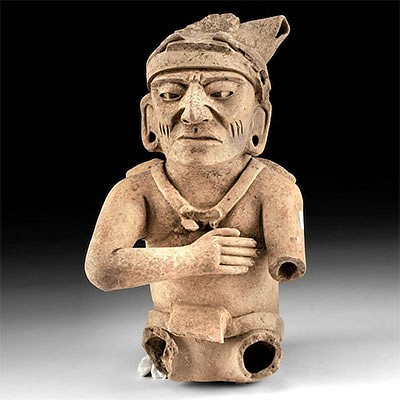Roman Leaded Bronze Strigil
Lot 21a
About Seller
Artemis Fine Arts
686 S Taylor Ave, Ste 106
Louisville, CO 80027
United States
Selling antiquities, ancient and ethnographic art online since 1993, Artemis Gallery specializes in Classical Antiquities (Egyptian, Greek, Roman, Near Eastern), Asian, Pre-Columbian, African / Tribal / Oceanographic art. Our extensive inventory includes pottery, stone, metal, wood, glass and textil...Read more
Categories
Estimate:
$700 - $1,050
Absentee vs Live bid
Two ways to bid:
- Leave a max absentee bid and the platform will bid on your behalf up to your maximum bid during the live auction.
- Bid live during the auction and your bids will be submitted real-time to the auctioneer.
Bid Increments
| Price | Bid Increment |
|---|---|
| $0 | $25 |
| $300 | $50 |
| $1,000 | $100 |
| $2,000 | $250 |
| $5,000 | $500 |
| $10,000 | $1,000 |
| $20,000 | $2,500 |
| $50,000 | $5,000 |
| $100,000 | $10,000 |
| $200,000 | $20,000 |
About Auction
By Artemis Fine Arts
Feb 3, 2022
Set Reminder
2022-02-03 10:00:00
2022-02-03 10:00:00
America/New_York
Bidsquare
Bidsquare : VARIETY SALE | Ancient, Asian, Ethnographic
https://www.bidsquare.com/auctions/artemis-gallery/variety-sale-ancient-asian-ethnographic-8833
Join us for our first sale of February with a spotlight on two fabulous collections, one from Lumberton, Texas, and the other from Whisnant Gallery in New Orleans. Artemis Fine Arts info@artemisgallery.com
Join us for our first sale of February with a spotlight on two fabulous collections, one from Lumberton, Texas, and the other from Whisnant Gallery in New Orleans. Artemis Fine Arts info@artemisgallery.com
- Lot Description
Roman, Imperial Period, ca. 1st to 3rd century CE. A lovely example of a strigil created from a single sheet of hammered leaded bronze with a wide, curved blade that tapers to a rounded end. The upper half of the blade straightens out before protruding just slightly along the bottom of the rectangular handle, and the handle itself is folded backwards to form a slender suspension loop. In the Classical World, athletes would apply olive oil to their bodies and scrape the skin's surface with a strigil to clean themselves. Demonstrating this, numerous ancient vase paintings depict athletes using strigils to cleanse themselves following exercise. Size: 0.625" W x 6.2" H (1.6 cm x 15.7 cm); 6.7" H (17 cm) on included custom stand.
Provenance: East Coast collection, New York Gallery, New York City, New York, USA, acquired before 2010
All items legal to buy/sell under U.S. Statute covering cultural patrimony Code 2600, CHAPTER 14, and are guaranteed to be as described or your money back.
A Certificate of Authenticity will accompany all winning bids.
b>PLEASE NOTE: Due to recent increases of shipments being seized by Australian & German customs (even for items with pre-UNESCO provenance), we will no longer ship b>PLEASE NOTE: Due to recent increases of shipments being seized by Australian & German customs (even for items with pre-UNESCO provenance), we will no longer ship firm.
Display stands not described as included/custom in the item description are for photography purposes only and will not be included with the item upon shipping.
#167381Professional restoration to entire handle and nearly invisible repair to midsection of blade, with resurfacing and overpainting along new material and break lines. Slight bending to overall form of blade, with encrustations and areas of oxidation, and light abrasions. Nice patina throughout.Condition
- Shipping Info
-
All shipping is handled in-house for your convenience. Your invoice from Artemis Gallery will include shipping calculation instructions. If in doubt, please inquire BEFORE bidding for estimated shipping costs for individual items.
-
- Buyer's Premium



 EUR
EUR CAD
CAD AUD
AUD GBP
GBP MXN
MXN HKD
HKD CNY
CNY MYR
MYR SEK
SEK SGD
SGD CHF
CHF THB
THB













